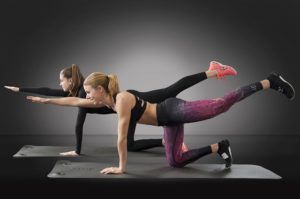These exercise tips, with weight loss in mind, are some general but important guidelines that are meant to help you become healthier, and learn more about what exercise is and does, and how to keep yourself in good shape when beginning an exercise and weight-loss program. Many of the ideas are normally incorporated into just about every exercise video done by the best physical fitness people. We go into some explanation of them in this and future articles, because when you know why they’re done, you begin doing such things automatically in your own exercise lifestyle. You should end up healthier, more conditioned, and feeling and looking better.

Building muscle is good: When you build more muscle, your body’s metabolism increases and burns calories more efficiently. This is why not just cardio exercises but also strength-training, or muscle training exercises, are recommended.
Skin tightening: Some experts say that cardio alone doesn’t provide the benefits to your skin that yoga and muscle training exercise does. In other words, yoga and strength training help tone your skin layers and tighten them. So during your weight loss or diet program, muscle-building exercises may help somewhat with the skin sag that sometimes can happen after a significant weight loss.
Make your exercise efficient: When you exercise, you can increase the number of calories burned by involving more muscles. For instance, walkers should be pumping their arms too. This is done for added calorie burn, but also for balance. When you do aerobics doing leg-kicks or stepping forward and back, if you add lifting your arms up and down too it adds a lot of extra exercise. If you do bicep curls, you might do them while marching or doing knee bends.
Modify exercises to suit you: If you are unaccustomed to an exercise or find an exercise difficult, modify it. Definitely. If people in the video are doing the movement with weights, you may want to do it with no weights in your hands. Simply moving your own body weight can serve to exercise you until you’re strong enough to handle some added weight.
And if a movement is difficult, make it slower — or smaller — or just “less.” Anyone just starting to exercise again probably shouldn’t be jumping (such as jumping while holding weights — can injure knees), or making jerking movements with limbs (in Tae Bo boxing exercises, use caution and do not “punch” quickly — can injure shoulder or elbow. Do a slow-motion punch, or just bring your fist half of the distance forward), or jerking your body upright. Such fast motion takes a great deal of muscle strength, and even fit people can injure themselves doing it.
When you’ve been living an inactive lifestyle, or nearly inactive, special care must be taken as you begin to exercise again. Some key things to remember are: Do short sets, make your movements slow ones, and protect yourself against injuries.
1. A short set of exercises is better than none, by several orders of magnitude. Do a little exercise because it’s so much better than none at all.
2. Slow, steady movement while stretching or exercising is safe; quick, jerky movements are often not safe and can strain a muscle or hurt a ligament. Just ask any physical therapist.
3. If it hurts enough for you to say or think, “Ow!” while you’re doing it, stop right away. Take the weight off that limb, or carefully lower yourself back down, or stop reaching that way. It is nearly always possible to gain a little more flexibility gradually by increasing what you do after a few days; but to force your body to assume a position it isn’t prepared to can tear ligaments. It’s easy NOT to harm your body: Don’t do things that hurt.
4. Warming up is more important the older you are — or if you’ve been on bed rest, or immobilized for a while — or if you have any serious health issues. A warmed-up body, like any engine, functions better.
5. Don’t forget stretching after exercise too, to cool down. Stretching after a workout can actually prevent soreness the next day.
– What is soreness, anyway? – It’s usually slight bruising, or tiny micro-tears in your muscles. Those tiny tears take usually 24 hours to heal. This is the main reason we’re told to work out every other day, NOT every day. Even fit people are instructed to work one set of muscles one day, then a different set the next day. Note: Walking may be done every day, because it isn’t as strenuous as other exercise. Our legs are about the strongest muscles we have and are very used to the motion. But if walking was a little too much the one day, then skip a day walking.
– Sometimes you don’t even feel sore until as long as day or two after a workout. What does this mean? — This could be what has been described as DOMS, or delayed onset muscle soreness, which may be caused by particular kinds of exercises. Some say DOMS is muscle damage caused by excessive “lengthening contractions” of muscles, and they recommend doing exercise that is isometric instead. Isometric exercise is a type of exercise in which you just tighten, then relax a muscle. You’re basically hardly moving at all, and definitely not lifting anything.
Whether you accept the ideas of fitness writers concerning DOMS or not, a couple of things are usually accepted about delayed soreness. It is usually due to unaccustomed exercise. Also,lifting heavy objects, or repeated lifting, is a frequent cause.
